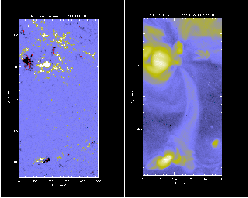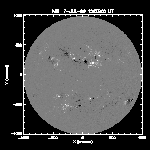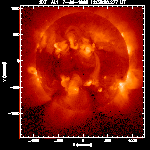Transequatorial loops and magnetic reconnection
Science Nugget: July 9, 1999
Introduction
This week's nugget continues to waffle on with a theme evolving from several previous nuggets regarding
transequatorial N-S coronal loops.
The new remarkable feature of this week's phenomena is the involvement
of the NS loop connections with newly emerging flux and with active-region
expansions.
To summarize the problems these loops present us with...
Large-scale coronal magnetic fields must result from a cyclic dynamo
mechanism of some sort, because they flip polarities in alternate cycles;
Dynamo theories akin to the Babcock picture cannot directly create
fields connecting the northern and southern hemispheres, ergo
Large-scale magnetic reconnection must be occurring to permit these
structures to exist.
But how does the reconnection proceed, what drives it, and what are its
consequences?
We note from
previous nuggets that the NS loops show up
quite well in Yohkoh/SXT images, which immediately implies high
temperature and suggests a signature for the reconnection.
S. Tsuneta suggested that loops rising from active regions could drive
the reconnection.
Do this week's remarkable observations fit this idea?
The Data
An MDI and an SXT image from that epoch:
A registered (thanks, Dom) image pair at higher resolution

A short movie:

A longer movie:

What we think we see
Really, there is a lot of speculation that can result from these
beautiful data.
We hasten to note that the SXT images are from our first-pass data
reduction, and we will later have more data with higher quality.
But we think we see the following features, mainly found from the
long movie:
There are two episodes of emerging flux in the south, and each
relates in a similar manner to the NS loop structures.
In both cases, the large-scale magnetic connections appear to be present
prior to the flux emergence, but
The northern footpoints match or are quite close to each other.
If they're the same, then a major reconnection needed to have taken
place.
At times during the development, a definite kink appeared (concave to the
west) strongly resembling the X-type interconnection studied by Tsuneta.
There is little evidence for motions resulting from and/or leading to
large-scale reconnection, however.
What does it mean?
It is a bit baffling.
We seem to have caught large-scale magnetic reconnection in the act, and
yet we don't see dramatic consequences.
Nevertheless, the loops are hot (measurements to be made, but "hot" by
comparison with SOHO EUV standards) and require energy input, but it
does not seem to be happening suddenly.
Perhaps the most logical inference would be that the reconnection is
proceeding in a gradual and benign manner, and that the NS loops largely
have been in place prior to the active-region flux emergences (a
"super-canopy"?).
July 9, 1999: Brian Handy, Hugh Hudson
(handy@isass0.solar.isas.ac.jp)
(hudson@isass0.solar.isas.ac.jp)


